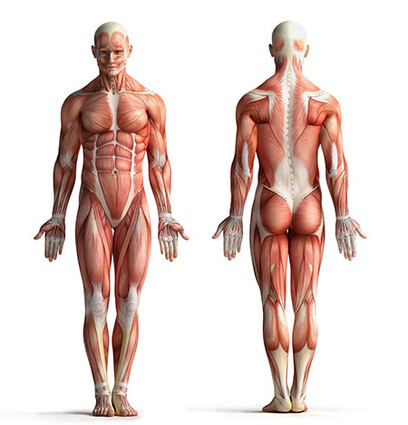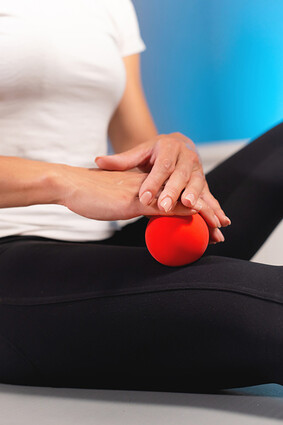Fixing You – What's in your web?
Last updated 4/11/2023 at 3:44pm
Anyone looking at a typical anatomical man diagram will see deep-pink muscle connected to bone by white ligament and tendon. But when it comes to what moves the body, that is simply not the whole picture. In the last decade our fascia, which was long thought to be just passive body tissue, has begun to receive some well-deserved attention.
Our myofascial web is an integral part of how our bodies move. The fascia (pronounced FAH-sha) is a network of tissue that spreads in continuous sheets throughout the entire body. It connects muscles, joints, and bones. It also wraps around our organs like scaffolding, supporting and keeping those organs in place. There are four different kinds of fascia (structural, intersectoral, visceral, and spinal), but they’re all connected in our web. In fact, if we were able to view the fascia in isolation, it would look like a complete hologram. Even a face would be recognizable.
The fascial system takes on many forms, from stiff to soft, depending on where it’s located in the body. For instance, the plantar fascia that runs from our heel bone to the base of our toes is naturally thick and strong while fascia located directly under the skin of our arms and legs is designed to be thin and elastic. Taking a microscopic peek at fascia in a living body, which scientists were only able to do for the first time about 20 years ago, we see fascia is not the passive connective and collagen tissue once assumed.
Fascia is in fact stretchy, expandable, and flexible. And most importantly, it is fluid. Fascia contains little glistening capsules of hyaluronan (HYE-al-URE-oh-nan), a polysaccharide produced by our bodies to regulate tissue responses during injury, promote repair and regeneration, and help calm inflammation. Those interested in seeing the activity of this fascial fluid can view Dr. Jean-Claude Guimberteau’s Living Fascia video on YouTube at https://www.youtube.com/watch?v=G_Eu-FdKDs8.
Fascia is beautifully organized and very flexible in its healthy state. When we keep our fascia healthy, we experience good body symmetry that can reduce the chance of injury and help us avoid chronic pain. Situations that can cause flexible fascia to become damaged may include traumatic injuries such as a fall or a car accident, repetitive movements like industrial work or keyboarding, and prolonged sitting or standing. If our myofascial web is damaged or traumatized, it’s like a ‘traffic jam’ that blocks a pathway across the body – a pathway that sometimes travels for quite a distance. A blockage in the pathway will cause the fascia to become dehydrated and less mobile, even compressed and knotted. These adhesions and restrictions in turn cause tightness and muscle shortening that inevitably pulls the body out of optimal alignment. The result can be headaches, back pain and sciatica, muscle stiffness, and muscular spasms.
Myofascial Release Therapy (MRT) is becoming popular for reversing myofascial restrictions. Receiving MFR Therapy from a practitioner is quite a different experience than Swedish, sports, or even deep-tissue massage. A skilled MRT practitioner will carefully locate and anchor restrictions, pause on the restriction to allow softening, and then perform very specialized leveraging movements to allow fascia to release and elongate. The release may be performed for up to five continuous minutes at one site. As restrictions ease, a reaction may be felt quite far away from the focus site because, as previously mentioned, our fascial pathways run throughout the entire body. A good parallel is to picture a tablecloth, where tugging one corner can change the position of everything else on the table.
Self-Myofascial Release (SMR) can be performed at home with a few simple tools, such as a golf ball, a tennis ball, and a foam roller. The technique is similar to MRT, and involves anchoring a restriction, allowing for softening, and holding to engage a subtle release. Thankfully, it’s not difficult to learn and in some instances can produce quick relief. Over the next several weeks, I’ll outline some of the most common areas where myofascial restrictions happen, and explain ways to safely perform home-based Self-MFR. Together let’s find out what’s in your web, and learn some techniques to keep your body working in optimal condition.
Janice H. Hoffman has been an American Council on Exercise gold certified medical exercise specialist since 2005. From 1998 to 2008 she was one of their Western Region faculty members, preparing new fitness professionals to pass certification exams. From 2002 until 2016 she was on the board of the Oregon Fibromyalgia Information Foundation as their exercise physiology advisor, and choreographed four of their exercise videos. From 2005 to 2014 she worked with chronic pain disorder and cancer survivorship exercise researchers at OHSU. Over a 30+ year career in fitness leadership she designed, implemented, and supervised exercise programs with the goal of helping individuals improve function, avoid injuries, and enhance overall well-being.
Hoffman currently works at The Nugget Newspaper.


















Reader Comments(0)